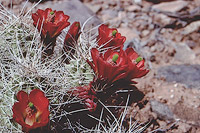 Desert cacti are often defined as the quintessential desert plant. Slow growing, leafless, drought tolerant, these plants endure in dry environments where other plants may succumb to the conditions. Add to their mistic is the fact that cactus fossils are unknown, thus their ancestry is just a guess.
Desert cacti are often defined as the quintessential desert plant. Slow growing, leafless, drought tolerant, these plants endure in dry environments where other plants may succumb to the conditions. Add to their mistic is the fact that cactus fossils are unknown, thus their ancestry is just a guess.
So, what makes a cactus so successful? Here is a deeper dive into the morphological and physiological characteristics of the cactus.
For the cacti that grow in the desert lands of southern Utah, these species fall into two categories: the typical stem or barrel cactus (known as cactoids) and the prickly pears (optuntioids) whose flattened pads are joined together like a third-graders art project.
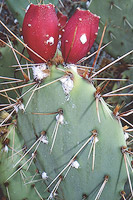 What these plants share are their waxy-coated stems that contain chlorophyll, the pigment necessary for photosynthesis, because these plants lack leaves. Instead, the leaves have modified over thousands of years of evolution, to become spines and thorns. This morphological trait, along with cells that can swell and hold moisture, enable these plants to either endure drought or take advantage of abundant soil moisture. Even the thorns play a role beyond providing some defense against predators; the thorns and fine hairs at the base of the spines reduce the desiccating nature of the dry desert wind blowing across the stems or pads.
What these plants share are their waxy-coated stems that contain chlorophyll, the pigment necessary for photosynthesis, because these plants lack leaves. Instead, the leaves have modified over thousands of years of evolution, to become spines and thorns. This morphological trait, along with cells that can swell and hold moisture, enable these plants to either endure drought or take advantage of abundant soil moisture. Even the thorns play a role beyond providing some defense against predators; the thorns and fine hairs at the base of the spines reduce the desiccating nature of the dry desert wind blowing across the stems or pads.
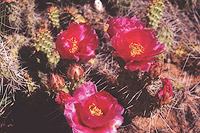 Internally, cacti have a unique process of photosynthesis that enables the plants to open small pores in the evening to allow for the transpiration of gases both into and out of the plant. The cooler evening hours minimize moisture lost to the atmosphere, and during the day these pores clamp shut while the plant undergoes its photosynthetic activity.
Internally, cacti have a unique process of photosynthesis that enables the plants to open small pores in the evening to allow for the transpiration of gases both into and out of the plant. The cooler evening hours minimize moisture lost to the atmosphere, and during the day these pores clamp shut while the plant undergoes its photosynthetic activity.
One additional adaptive feature of the prickly pears is that during times of drought stress, the outer pads can be dropped by the plant, sort of like the way deciduous trees drop their leaves in the fall, to keep the core alive.
One of the earliest blooming species is the claret cup cactus (Echinocereus triglochidiatus). Echinocereus means “like a hedgehog” referring to the cacti’s shape and spiny appearance. Triglochidiatus means “three barbed bristles” and refers to the straight spines, often in clusters of three, which radiate out from a central point. Low growing and clump-forming, these cacti produce brilliant scarlet-colored flowers in April and May which attract hummingbirds and insects as pollinators.
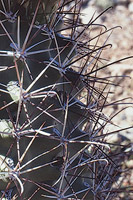
Another barrel-shaped cactus is the Whipple’s fishhook cactus (Sclerocactus whipplei). The common and species name honors Amiel Wicks Whipple (1818-1863), a topographical engineer who led the Pacific Railroad Survey along the 35th Parallel. During these surveys, the company’s surgeon held a dual role as naturalist, and collected plants and wildlife new to science. Sclerocactus is from Greek words meaning “hard thistle” in reference to the spines. This species has fishhook-shaped spines and light purple flowers that are pollinated by insects.
Several species of prickly pear cactus (Opuntia sp.), with flattened pads joined together and prickly reddish fruits, grow in the region. These plants may grow in profusion where there has been extensive grazing. Though cattle avoid the cacti, you might see where a woodrat has chewed on a pad or find a fruit hauled back to the creature’s nest.
Some prickly pears bear white “fluff” on the pads. This protective cover houses the cochineal bug, a scale insect which feeds on the plant. These insects secrete a bright red fluid that is foul-tasting but also has been used for thousands of years as a natural dye and medicine.
At home in this land of little rain, the cacti endure and erupt in color during the spring.
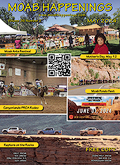
 Desert cacti are often defined as the quintessential desert plant. Slow growing, leafless, drought tolerant, these plants endure in dry environments where other plants may succumb to the conditions. Add to their mistic is the fact that cactus fossils are unknown, thus their ancestry is just a guess.
Desert cacti are often defined as the quintessential desert plant. Slow growing, leafless, drought tolerant, these plants endure in dry environments where other plants may succumb to the conditions. Add to their mistic is the fact that cactus fossils are unknown, thus their ancestry is just a guess.  What these plants share are their waxy-coated stems that contain chlorophyll, the pigment necessary for photosynthesis, because these plants lack leaves. Instead, the leaves have modified over thousands of years of evolution, to become spines and thorns. This morphological trait, along with cells that can swell and hold moisture, enable these plants to either endure drought or take advantage of abundant soil moisture. Even the thorns play a role beyond providing some defense against predators; the thorns and fine hairs at the base of the spines reduce the desiccating nature of the dry desert wind blowing across the stems or pads.
What these plants share are their waxy-coated stems that contain chlorophyll, the pigment necessary for photosynthesis, because these plants lack leaves. Instead, the leaves have modified over thousands of years of evolution, to become spines and thorns. This morphological trait, along with cells that can swell and hold moisture, enable these plants to either endure drought or take advantage of abundant soil moisture. Even the thorns play a role beyond providing some defense against predators; the thorns and fine hairs at the base of the spines reduce the desiccating nature of the dry desert wind blowing across the stems or pads. Internally, cacti have a unique process of photosynthesis that enables the plants to open small pores in the evening to allow for the transpiration of gases both into and out of the plant. The cooler evening hours minimize moisture lost to the atmosphere, and during the day these pores clamp shut while the plant undergoes its photosynthetic activity.
Internally, cacti have a unique process of photosynthesis that enables the plants to open small pores in the evening to allow for the transpiration of gases both into and out of the plant. The cooler evening hours minimize moisture lost to the atmosphere, and during the day these pores clamp shut while the plant undergoes its photosynthetic activity.
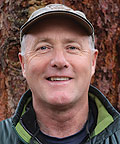 A natural history writer.
A natural history writer.